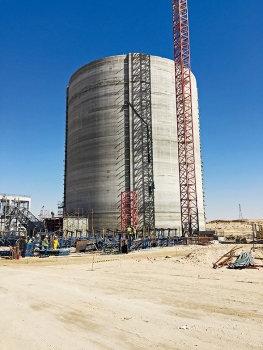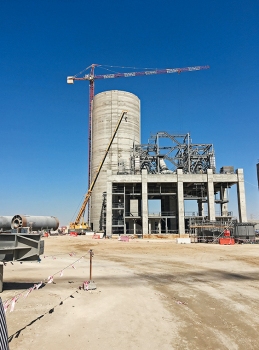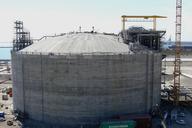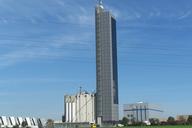New silos for the Qatar National Cement Company
Founded in 1965, Qatar National Cement Company (QNCC) is a major producer of Portland cement, sulphate resistant cement, hydrated lime, calcined lime, washed sand and clinker. QNCC wants to increase its annual cement production in order to satisfy the increasing demand for construction projects due to the Soccer World Cup that will take place in Qatar in 2022.
For this reason, QNCC awarded the FIVES company with the contract for the construction of a 5th production line in the town of Umm-Bab in western Qatar that will have a capacity of 5,000 t of clinker per day once completed.
The new production facility also required the construction of four silos (two cement silos, one raw meal silo, one clinker silo) that were post-tensioned using loop tendons. DYWIDAG-Systems International GmbH, GBU, Germany proposed a special solution to the planners Peter and Lochner that consisted of changing the planned different tendon types to uniform DYWIDAG strand tendons with SD plate anchorages and post-tensioning systems with MA anchorages. By reducing the tendon sizes, the number of required stressing jacks could also be reduced. The horizontal tendons were simultaneously stressed using two jacks.
86 m high raw meal silo
For the two new, 72 m high, 35 m Ø cement silos, DSI Middle East produced and supplied 162 strand tendons per silo, each 39 m long, with a total strand tonnage of 102 t. In the 86 m high raw meal silo with a 32 m diameter, 112 approx. 38 m long strand tendons with a strand tonnage of 57 t were used. In the 46 m high, 51 m Ø clinker silo, 128 strand tendons in lengths of approx. 54 m and with a strand tonnage of 81 t were installed.
Air freight from Germany
The installation of the anchorages for the two cement silos that were built using the slipform construction technique had to be carried out shortly after the SIAC company awarded the contract to DSI Middle East. All of the parts that had to be imbedded in the concrete were shipped from Germany via air freight. The SD plate anchorages according to ETA 13/0815 had a decisive advantage in comparison to MA anchorages: For the SD anchorages, only a lightweight plastic trumpet had to be installed before concreting because the heavy steel component of the SD anchorage is only required at the time of stressing. Due to the low weight of the required plastic trumpets, the additional cost for air freight was low. Since the steel anchorage plates were only needed later on, they could be shipped via sea freight from DSI's central warehouse in Langenfeld to Qatar.
The installation of the strand tendons including post-tensioning was completed within 9 months' time.
Structure Types
- About this
data sheet - Product-ID
7552 - Published on:
06/12/2017 - Last updated on:
17/11/2021





